|
Vern Speich landed three times at Tucson. For all three landings he gave his home base as Santa Ana, CA. His first visit was on Sunday, July 22, 1928 at 8:55AM. He was flying the International F-17 NC1675. Speich was the owner of this airplane (see below). He arrived from Miami, FL with his passenger Lt. Joseph R. Hargrove. They departed 35-minutes later for Santa Ana. He wrote in the remarks column of the Register, "Cross country." It was, indeed. The ca. July 2, 1928 news article, below, shows him before his departure eastbound from Newport Beach, CA to Miami. He holds a brochure from Newport Beach and some envelopes in his hand.
Speich Departure for Miami, Ca. July, 1928 (Source: Lynn)
 |
Vern Speich, Return Trip (Source: Lynn)
 |
His flight to Miami was successful in his International, which he landed in Miami at the, "... N.W. Fifty-fourth street flying field at 4:20 p.m." The flight was a big deal and many pages of his scrap book are dedicated to news articles and congratulatory telegrams. One article makes it clear that this was the first time ever that an Elks delegate had flown cross-country from California to the convention. He was in the air 39 hours and five minutes, for a total distance of 3,670 miles.
The interesting article at left, ca. July, 1928, lists his itinerary for the return trip to California. From Miami he stopped at Jacksonville, FL, Mobile, AL, Wiggins, MS, Baton Rouge, LA, Beaumont, San Antonio, Del Rio, Dryden and El Paso, TX (Texas is a big state for a small airplane!), and Tucson.
The article also mentions a forced landing near Valpariso, FL where his airplane was "slightly damaged." The repairs were rapid, though, as his round trip only took 20 days.
This article is also interesting because of Speich's importation of two "crocodiles" from Florida. These were no doubt alligators (Alligator mississippiensis), since, although there are American crocodiles (Crocodylus acutus) in southern Florida, they were and are very rare. It was usually young alligators that were sold to tourists before conservation groups began their watchdog efforts to protect alligators. As far as Speich "training" alligators, when was the last time you saw a trained alligator show?
New York Times, October 13, 1929 (Source: NASM)
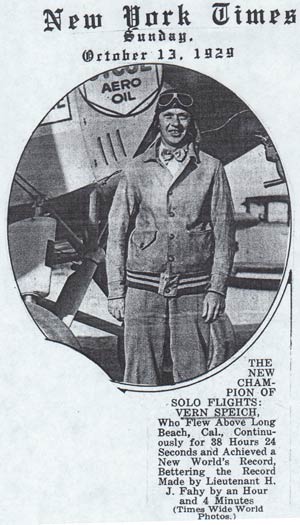 |
His second landing at Tucson took place on Thursday, February 5, 1931. This time he was solo in the Stearman NC5600. He was southbound through Tucson from Santa Ana to Nogales, AZ near the border with Mexico. Speich owned an auto agency in Santa Ana. He learned to fly at Register pilot Eddie Martin's airport.
His final visit at Tucson was on Sunday, January 3, 1932. This time he was also southbound from Imperial, CA, stopping at Tucson on his way to Douglas, AZ again near the border with Mexico and a little east of Nogales. He was solo in the B-6000 Travel Air NC9914.
Speich's NASM biographical file (cited, left sidebar) has a few news articles, mostly related to his endurance record set in October, 1929 when he was 33 years old. At right is an example from the New York Times. He stands in front of his airplane, a Zenith Z-6, NX578K (not a Register airplane). The airplane was powered by a 220HP Wright J-5 engine. Speich financed the flight by himself on behalf of his affiliation with the Zenith Aircraft Corporation.
Note mention in this article of fellow Register pilot Hub Fahy. It took Speich three attempts before he finally surpassed Fahy's mark. Below is a news photograph from an unidentified, undated source that shows both Speich and his airplane, probably before the record attempt.
Below are undated and unsourced news articles, documents and photographs shared by Speich's granddaughter (cited, right sidebar). In preparation for record setting flights during the 1920s and 30s, most pilots joined the National Aeronautic Association (NAA). The NAA was the official record keeper for various attempts: speed, distance, altitude or endurance. Below is Speich's NAA certificate. He was granted membership in August, 1929, just a month or so before his record attempt.
National Aeronautics Association Certificate, August 26, 1929 (Source: Lynn)
 |
Below, a pre-event photo of Speich and his airplane. He was sponsored by Associated Aviation gasoline and Cycol aviation oil, both of which were used on the flight.
Vern Speich and his Zenith (Source: Lynn)
 |
The article below appeared under the banner headling, "SPEICH TRIUMPHANT IN SOLO MARK QUEST." The REFERENCE by Plehinger states he departed at 6:26:15AM on October 2nd and landed at 8:27:03PM the next day for an unrefueled duration of 38 hours and 48 seconds (note discrepancy with article above, right, and in the Blue Book of Aviation reference, below). In the "flashlight picture" below, both Speich and his wife appear exhausted. Exhausted as he was, his record was quickly broken by men and women fliers alike.
Unsourced News Article, Ca. October, 1929 (Source: Lynn)
 |
According to other articles shared by his granddaughter, this was the third attempt made at the record; the first being on August 23rd. According to another article, Speich's airplane was painted blue with yellow wings and a red nose, and it was christened "Wanderer" by a young woman, Lida Hilliggoss (or Ida Hilligoss, depending on which newspaper you read), who won the airplane name contest.
The image below shows Speich second from left with a group of unidentified men. The airplane is a Zenith, but it is not known for sure if it is the one he flew for his record (there were three of the model built). This airplane has a special cabin installed between the top wing and the fuselage.
Vern Speich (Second From Left) With Zenith, Ca. 1929 (Source: Lynn)
 |
Image below shows the same airplane and provides a better look at the roughed-in cabin structure.
Vern Speich (Left) With Zenith, Ca. 1929 (Source: Lynn)
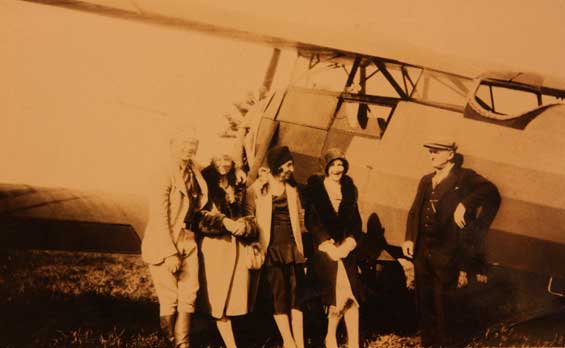 |
Another entry in his NASM folder is a short, thumbnail biography in the Blue Book of Aviation for 1932. Below is a copy of that entry. It gives his birth date as August 6, 1895. This is corroborated by California Death Records after 1940, which also states he died of a heart attack at age 46 on Jan 26, 1942 in California (Los Angeles County).
Vern Speich in the Blue Book of Aviation, 1932 (Source: NASM)
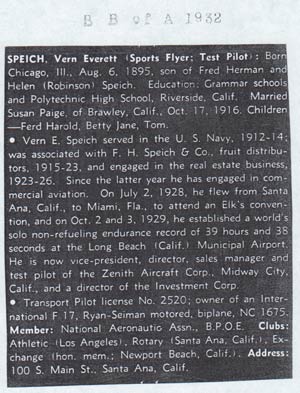 |
Three items are revealed in this Blue Book entry. The first is that he served in the Navy from 1912-14. The second is the reason for his first landing at Tucson: He was returning from the Elk's convention in Miami, FL. The third is that he was the owner of the airplane he brought through Tucson the first time (Please follow the link to that airplane, at top, for further information).
Note the discrepancy in the reporting of Speich's endurance record: 39 hours and 38 seconds according to the Blue book; 38 hours and 24 seconds according to The New York Times. The discrepancy shows up again in the Blue Book, as well as news articles from the Newark Star-Eagle and the New York Sun from his NASM folder, state the time as 38 hours and 48 seconds. Take your pick, but 38:00:48 sounds like the best bet.
Regardless of the timing, he flew NX578K carrying 452 gallons of gas, including 400 gallons in an auxiliary tank. He burned 417 gallons. The Z-6 had an open cockpit in the rear and an enclosed cabin for 3, 5, or 7 passengers. Speich was a minority stockholder in Zenith.
Sol Spiegel was chief mechanic for Zenith Aircraft Corp. and served as chief mechanic for Speich during his solo record. You can see a good photograph of Spiegel at the top of Register pilot R.O.D. Sullivan's page.
Below, from the Centralia (WA) Daily Chronicle for October 19, 1929, a typical article from non-California newspapers describing Speich's record flight.
Centralia (WA) Daily Chronicle, October 19, 1929 (Source: Gerow)
 |
Note the column fillers in the lower left corner. Prohibition was the law in the United States in 1929.
The Woodland Daily Democrat, Woodland, CA carried the following advertisment on October 10, 1929. The image gives an idea of what Speich's Zenith airplane looked like.
Petroleum Advertisement, Woodland Daily Democrat, October 10, 1929 (Source: Gerow)
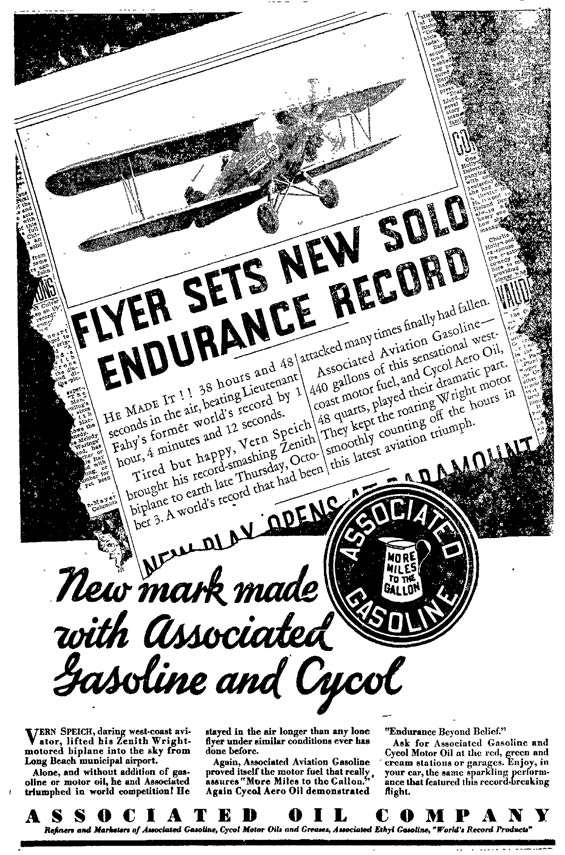 |
Vern Speich, Ca. 1928-1929, Location Unknown (Source: Lynn)
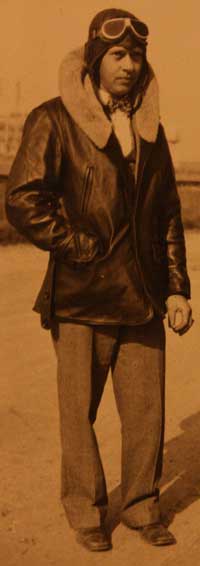 |
Vern Speich, 1930s (Source: Lynn)
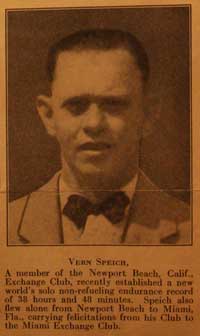 |
Speich held his record for a time and other news articles, on into 1932, talked about it, or cited others' record attempts that came close. One, in the Clearfield (PA) Progress of May 2, 1930, reported on a French woman, Mlle. Lena Bernstein, who came close to Speich's mark by remaining aloft at Le Bourget for 35:46:55. She did best the previous female mark of 26:21 set by Elinor Smith at Roosevelt Field, NY the previous April. She also beat the mark of Maryse Bastie, another French aviator who flew 26:46:30 the previous July.
The Portsmouth (NH) Herald and the San Antonio (TX) Express of May 31, 1931 reported that Speich was planning a Seattle, WA to Japan flight during July using a specially built Zenith aircraft. The flight was not made, rather two other Register pilots Cecil Allen and Hugh Herndon and their copilots separately flew the route at two different times. Allen, with copilot Don Moyle took off from Japan on September 8, 1931. On September 25th they landed at Seattle. Please direct your browser to Allen's link to discover why it took them so long. As well, Hugh Herndon, Jr., New York socialite, with Clyde Pangborn,
flew the first plane (a Bellanca Skyrocket named “Miss
Veedol”) across the Pacific Ocean nonstop, October
3, 1931.
In January, 1932 Speich and three other pilots embarked on a hunting trip from California into Baja, Mexico. A couple of news articles documented the problems they had with border security personnel try to extort money from them for clear passage. While at the time there was no legal fee structure for allowing aircraft and people into Mexico. However, border officials tried to charge what the article said was $100 (dollars) per airplane as a courtesy fee, plus $15 per person as a further tax. That was a huge amount of money in 1932, so the newspaper probably meant to say pesos instead of dollars (see the receipt below, in pesos). They were able to reduce the total fee to $35 (pesos; the dollar sign is used to signify pesos as well as dollars) per airplane, and an agreement to pay an additional $15 on the way back. Such was (and still is according to some travelers) the way of travel south of the border. Below is the permit issued to Speich for his passage into Mexico, dated January 18, 1932. Speich paid his $15.
Mexico, "Bonding Company" Permit, January 18, 1932 (Source: Lynn)
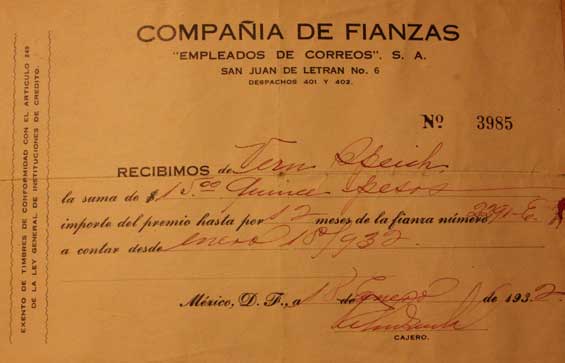 |
The large print at the top of the document reads "Bonding Company" and "postal workers." Below is the first paragraph of an undated news article that cites the return of the Mexico flight. Note mention in the article of Register pilot Robert Jeffrey and Register passenger Ralph Mitchell. The article continued by describing the tribulations of the trip and their challenges at border crossings.
Vern Speich, Mexico Trip, Ca. January, 1932 (Source: Lynn)
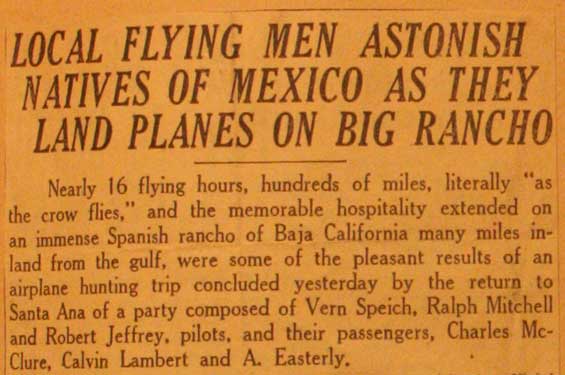 |
Pilot Speich was born on August 6, 1895, and died January 26, 1942.
---o0o---
Dossier 2.1.149
THIS PAGE UPLOADED: 12/24/11 REVISED: 02/08/13
|
















